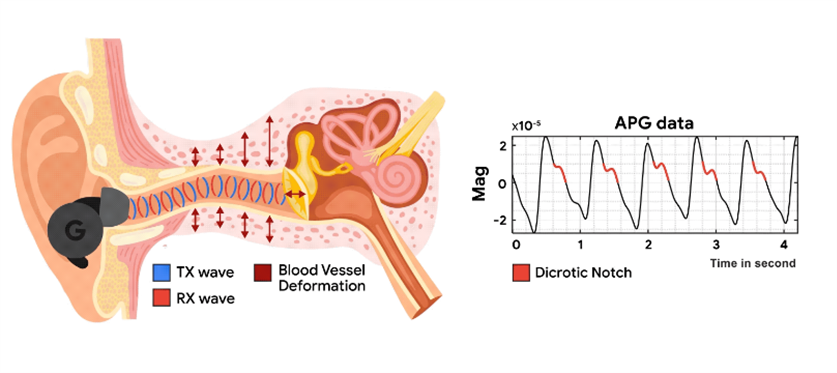Carding 4 Carders
Professional
- Messages
- 2,730
- Reaction score
- 1,466
- Points
- 113
Google's technology allows you to listen not only to music, but also to your heart.
In a new study, Google introduced an innovative technology in the field of audio-plethysmography (APG). Now wireless headphones with Active Noise Cancellation (ANC) can become smart devices for health monitoring, and all this thanks to a simple software update.
Google claims that the ear canal provides optimal conditions for measuring health indicators. APG technology works on the principle of sending a low-intensity ultrasonic signal (TX wave) through the speakers of ANC headphones, which, bouncing off the walls of the ear canal, causes an echo. The echo reflects subtle changes in the ear canal caused by heartbeat and blood pressure.
The built-in microphones of the headphones analyze the received signal (echo) (RX wave), which has the form of a pulse-like wave, which is synchronized with the user's heartbeat and allows you to determine the pulse and other circulatory parameters.

APG technology operation diagram
Modern headphones use microphones to implement the active noise reduction function. Microphones can capture various biosignatures inside and outside the ear canal, which opens up opportunities for health monitoring. However, the use of such technologies in commercial headphones was difficult. Audioplethysmography solves these problems by overcoming the hardware limitations of headphones.
One of the key advantages of the new technology is its reliability. Even when playing music or the headphones fit imperfectly in your ear, the system continues to work accurately. APG can also operate simultaneously on different frequencies, which allows you to get a better signal.
Studies conducted with the participation of 153 people confirmed the high accuracy of APG technology. The method provides stable and accurate measurements of pulse and heart rate variability, while not depending on the skin tone or size of the ear canal.
Google believes that the new approach is significantly superior to traditional monitoring methods such as photoplethysmograms (PPG) and electrocardiograms (ECG), especially in terms of convenience and cost for users.
APG, as Google notes, "not only turns ordinary headphones into smart health monitoring devices, but also opens up new horizons in the field of medical research, making health monitoring more accessible."
Despite the fact that the technology was developed in collaboration with various Google departments, including Google Health and the legal department, the future of its implementation in the company's products, such as Pixel Buds, is still questionable.
In a new study, Google introduced an innovative technology in the field of audio-plethysmography (APG). Now wireless headphones with Active Noise Cancellation (ANC) can become smart devices for health monitoring, and all this thanks to a simple software update.
Google claims that the ear canal provides optimal conditions for measuring health indicators. APG technology works on the principle of sending a low-intensity ultrasonic signal (TX wave) through the speakers of ANC headphones, which, bouncing off the walls of the ear canal, causes an echo. The echo reflects subtle changes in the ear canal caused by heartbeat and blood pressure.
The built-in microphones of the headphones analyze the received signal (echo) (RX wave), which has the form of a pulse-like wave, which is synchronized with the user's heartbeat and allows you to determine the pulse and other circulatory parameters.

APG technology operation diagram
Modern headphones use microphones to implement the active noise reduction function. Microphones can capture various biosignatures inside and outside the ear canal, which opens up opportunities for health monitoring. However, the use of such technologies in commercial headphones was difficult. Audioplethysmography solves these problems by overcoming the hardware limitations of headphones.
One of the key advantages of the new technology is its reliability. Even when playing music or the headphones fit imperfectly in your ear, the system continues to work accurately. APG can also operate simultaneously on different frequencies, which allows you to get a better signal.
Studies conducted with the participation of 153 people confirmed the high accuracy of APG technology. The method provides stable and accurate measurements of pulse and heart rate variability, while not depending on the skin tone or size of the ear canal.
Google believes that the new approach is significantly superior to traditional monitoring methods such as photoplethysmograms (PPG) and electrocardiograms (ECG), especially in terms of convenience and cost for users.
APG, as Google notes, "not only turns ordinary headphones into smart health monitoring devices, but also opens up new horizons in the field of medical research, making health monitoring more accessible."
Despite the fact that the technology was developed in collaboration with various Google departments, including Google Health and the legal department, the future of its implementation in the company's products, such as Pixel Buds, is still questionable.
